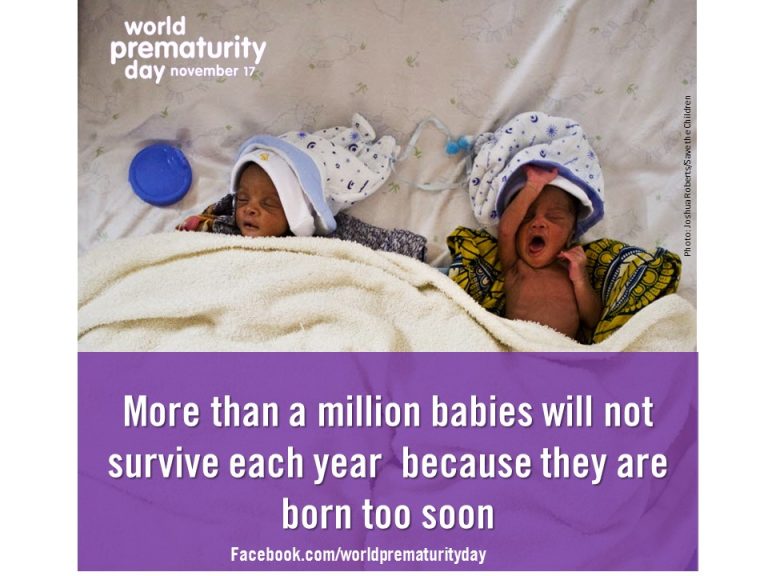By Olive Cocoman, Kadi Toure, Mary Kinney
World Prematurity Day is a key moment to focus global attention on the leading cause of child deaths under age 5 – complications from preterm birth – which accounted for an estimated 1 million deaths in 2015. Efforts for World Prematurity Day support the implementation of the Every Woman Every Child Global Strategy for Women’s, Children’s and Adolescents’ Health.
Preterm birth prevention, diagnosis, and management are collectively a smart strategy to accelerate achievement of the global goal to end all preventable newborn and child deaths by 2030. This strategy will simultaneously reduce maternal deaths and stillbirths and related health system costs. While World Prematurity Day is an opportunity to call attention to the heavy burden of death and disability and the pain and suffering that preterm birth causes, it is also a chance to acknowledge the many innovations, initiatives and efforts charting bold new courses in addressing preterm birth since the launch of the Every Newborn action plan (ENAP) in 2014.
Innovations and initiatives that are charting bold new courses in addressing preterm birth include:
- Every Woman Every Child Innovation Marketplace: an alliance involving Grand Challenges Canada, the Bill and Melinda Gates Foundation, USAID and the UBS-Optimus Foundation to accelerate adoption of 20 new maternal and child health technologies by 2020 with a special focus on innovations that target the leading causes of newborn mortality (www.everywomaneverychild.org/networks/innovation-marketplace).
- Born on Time: a public-private collaboration between the Government of Canada, Johnson & Johnson, World Vision, Save the Children and Plan International focused on reducing preterm birth rates in Mali, Bangladesh and Ethiopia (bornontime.org).
- Helping Babies Grow: an initiative of Laerdal Global Health to help vulnerable newborns thrive by promoting breastfeeding, kangaroo mother care and staff training in preterm care (laerdalglobalhealth.com).
- Preterm Birth Initiative: a partnership between the Bill & Melinda Gates Foundation, Lynn and Marc Benioff, and the University of California–San Francisco, and several East African countries to test new approaches to reducing preterm deaths (ucsf.edu).
- Every Preemie—SCALE: a USAID-funded project designed to catalyse the global and national conversation around preterm birth and low birth weight in 25 priority maternal and child health countries, primarily in Africa and SE Asia (everypreemie.org).
- Preventing Preterm Birth Initiative: Grand Challenge in Global Health, administered by GAPPS, to accelerate research by funding projects focused on discovering and developing interventions to prevent preterm birth, with a focus on prevention strategies applicable in low-resource, high-burden settings (gapps.org/healthybirth).
- The new World Health Organization Quality Improvement Framework: these standards and guidelines for maternal and newborn health provide clear guidance to countries on what they can do to address the burden of preterm births.
- Quality, Equity and Dignity for All Mothers and Babies: an integrated maternal-newborn health advocacy movement to support a strong country-focused drive for quality maternal and newborn care with the technical support of UN agencies.
As part of the global ENAP efforts, an online survey – ENAP inpatient care for small and sick newborns – has been developed for newborn health experts to define how to measure service readiness for inpatient care of small and sick newborns. Standardized measurement of emergency obstetric care has improved tracking and accountability for care at birth, however, readiness to provide inpatient care of small and sick newborns is not defined or tracked. Take the survey using bit.ly/2eZpEBa.
Last week, WHO published the most comprehensive antenatal care guidelines to date which include recommendations on key interventions which can help prevent negative health outcomes, including preterm birth and stillbirths. These include dietary recommendations on nutrition, follow up on substance abuse, introduction of ultrasound scans to help determine gestational age and detect multiple pregnancies (both linked to preterm births), and increasing the number of contacts with health care professionals during this period, to ensure effective identification and management of other risk factors, such as infections. See http://www.who.int/maternal_child_adolescent/topics/newborn/care_of_preterm/en/.
Preventing deaths and complications from preterm birth starts with a healthy pregnancy and good quality care through pregnancy, birth and in the first week and month of life. The continuity of midwifery led care in settings where there are effective midwifery services, and this has been shown to reduce prematurity by around 24%. Without a major push, we will not reach the Global Goal, endorsed by 193 countries, to end all preventable newborn and child deaths by 2030.
